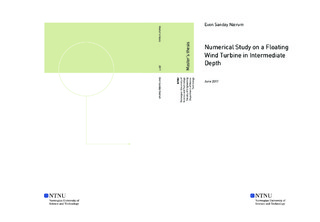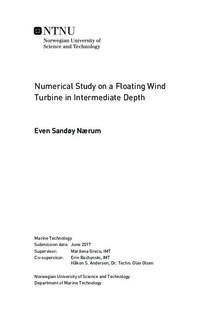| dc.description.abstract | Floating wind turbines are considered to be a promising source for renewable energy. Offshore wind power production is moving towards larger turbines and deeper water, and FWT's can unlock areas of rich wind resources currently unavailable due to large water depths. The application of FWT's do, however, come with engineering challenges, especially in the intermediate water range. This thesis aims to map out the added hydrodynamic implications of a semi-submersible FWT concept in intermediate water by numerical analysis. Viscous effects have been given a particular consideration in the numerical modelling, and consequently it was also decided to investigate the damping effects due to heave plates.
The North Sea is considered viable for floating wind production due to high average wind speeds. 3 locations in this area, with water depths of 50, 80 and 110 meters, were therefore selected to investigate the FWT behavior in the intermediate water range. Joint distribution models for wind and waves were used to establish extreme state and operational environmental cases for analysis.
Previous studies have indicated that slow drift excitation forces are particularly important in shallow and intermediate water. Experiments have shown that this force contribution increases in this range, and that it can be underestimated by numerical methods in such conditions. Past studies have also indicated that the relative wave velocity at the structure can significantly change viscous damping and flow separation due to sharp edges. Heave plates are often designed for semi-submersibles to take advantage of this effect, as high damping coefficients and flow separation can cause favorable damping on the structure. Due to past experiments, second-order potential theory was used to establish slow drift excitation forces in the intermediate range. Additionally, 3 alternative heave plate configurations were proposed for the 6 MW OO-Star Wind Floater, to possibly uncover parameters with better heave stability.
The numerical modelling was based on the 6 MW OO-Star Wind Floater, which is a semi-submersible FWT concept developed by Dr. Techn. Olav Olsen AS. Coupled aero-hydro-servo-elastic analysis were carried out by SIMO/RIFLEX-coupling in SIMA. An iterative procedure was proposed to obtain reasonable estimates for the viscous forces in each environmental case. In this procedure, the KC-numbers of the OO Star hull components were obtained through a statistical consideration for each sea state, and KC-dependent viscous force coefficients were established based on a literature study. A separate catenary mooring configuration was designed for each water depth.
The global time domain analysis confirmed that difference-frequency excitation forces had a considerable contribution to the FWT response. This force contribution also increased with decreasing water depth, and it was especially governing for high wave periods. In extreme conditions, the OO-Star Wind Floater response in surge and pitch was directly affected by this, and it was concluded that depth effects will change the design parameters for the OO-Star Wind Floater in the intermediate water range.
Additionally, the first order excitation forces also experienced depth effects. This load contribution was consistently lower for the 50 meter model. As a consequence, the heave response in this depth was smaller than for the other depths.
A design with an extra heave plate, in the same material and geometry as the original plate, improved the heave response. In extreme conditions, the response in this degree of freedom was 8.7 % lower than the response of the original plate. The new design also experienced a lower response in surge. However, further studies are needed to determine whether the reduced response will increase the lifetime of the OO Star enough to defend a higher cost of material. | en |

